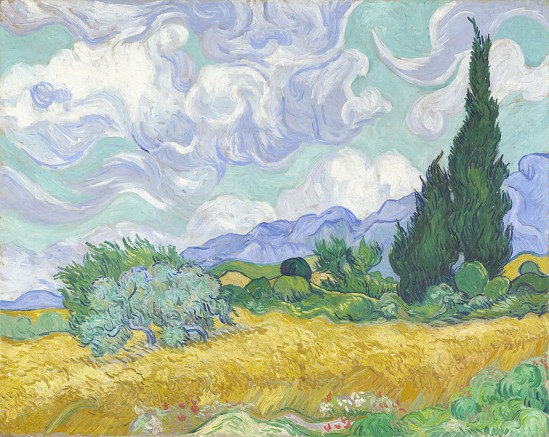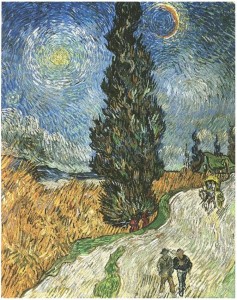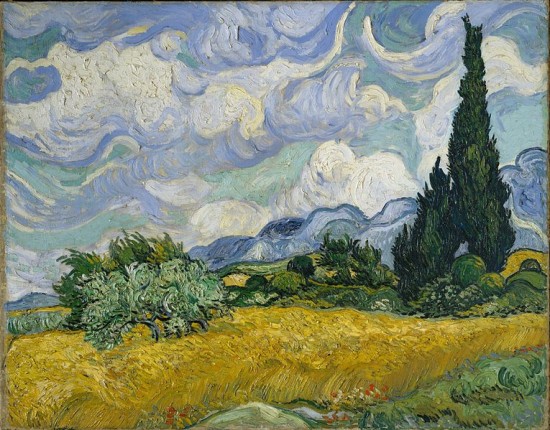Van Gogh's "Wheatfield in Cypress" - National Musuem, London version. Click for larger view.
Over the last few months my appreciation of Van Gogh's work has grown quite a bit as I've bought a few prints of his paintings. One of them is "A Wheat Field With Cypresses." There are three versions of this painting. I have the one pictured above which is from the National Gallery in London.
Another version of the painting is at The Met in New York City (image below) and the thrid print is held by a private art collector. The Met version was bought, then donated to the museum, by Walter H. Annenberg in 1993 for $57 million making it one of the most expensive paintings ever sold.
Van Gogh's spiritual connection to wheat fields
- Van Gogh used the digger and ploughman as symbols of struggle to reach the kingdom of God.
- He was particularly enamored with "the good God sun" and called anyone who didn't believe in the sun infidels. The painting of the haloed sun was a characteristic style seen in many of his paintings, representing the divine, in reference to the nimbus in Delacroix's Christ Asleep During the Tempest.
- Van Gogh found storms important for their restorative nature, symbolizing "the better times of pure air and the rejuvenation of all society." Van Gogh also found storms to reveal the divine.
They were painted during Van Gogh's time in a mental asylum
After a series of breakdowns in the Winter of 1888, Van Gogh voluntarily enetered the French mental asylum Saint-Rémy near Arles in May 1898. After a few months of only being within the grounds of the asylum, he started to venture out to the countryside to paint. It is over this time that he created these three paintings. He considered this painting one of his best summer canvases. In a letter to his brother around this time, Van Gogh described the field:
"I have a canvas of cypresses with some ears of wheat, some poppies, a blue sky like a piece of Scotch plaid; the former painted with a thick impasto … and the wheat field in the sun, which represents the extreme heat, very thick too."
Some analysis of the piece
BernieRosage analyses the painting and hits on the pieces that I feel when I look at it:
As I view Wheat Fields and Cypress Trees, I get the sense that I am there standing in the field feeling the wind blowing on my face. I can see the wheat swaying and the clouds rolling. This effect is echoed in Van Gogh’s brushwork as each stroke seems to move. The impasto texture only adds to this sensation for me. It’s as if Van Gogh wants me to feel the sensations he felt while painting this! I do not know if he painted this “en plein aire” (on location) but I’m sure that it was at least done from plein air studies and/or memories of the open air… it suggests that to strongly not to have been experienced firsthand.
A little more analyses over at VanGoghArt focuses on the contrasts:
Although restless beyond measure, with few straight lines, this landscape is one of the most classic in conception among Van Gogh's works. It is build up in great bands that traverse the entire space. The tall dark cypress tress at one side offer a powerful contrast to the prevailing horizontals, which they resemble in form. The oppositions of warm and cool, the proportioning of parts, the relative height of sky and earth on the two sides, the horizontal intervals which we can measure on the silhouette of the distant mountain, twice broken by trees – all these are perfectly legible and well balanced.
Buying a print
If you are interested in purchasing a print of this piece, you may want to check out the high qualiy Giclee prints over at Art.com.
Another Cypress Work I Like

I own this van Gogh print, "Road with Cypress and Star", and really like it also.
More of Van Gogh's Work
This flickr set has some of Van Gogh's best works:
